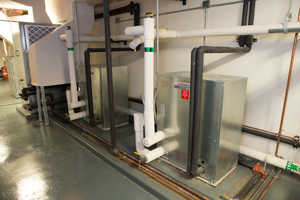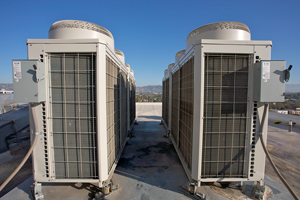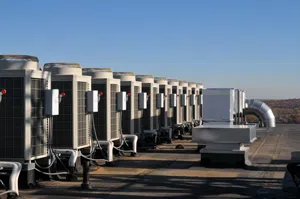Position your company for growth as a technology leader
Expanding from solely residential work to include commercial projects can be challenging. We faced this challenge ourselves at Conditioned Air, but once we made the leap we were committed to keeping pace with industry innovations and improved methods, as well as education and progressive thinking.
One way to create a strong, competitive position for your company when expanding into the commercial market is to offer Variable Refrigerant Flow (VRF) zoning systems. These systems connect one air-source outdoor unit, or water-source condenser, to as many as 50 indoor air handlers. This connection happens through small piping and electrical wiring, making these systems less invasive than their traditional chilled water counterparts.
VRF zoning technology is also more discreet in terms of noise and design. It’s a technology that had already spread throughout much of the world, but was new to the U.S. when we first became interested in it 10 years ago.
Once we learned about its versatility in commercial projects, we decided to add VRF zoning to our product line — and we've even installed a VRF zoning system in our own facility, which serves 14 offices each with its own control.
We’ve positioned ourselves for a strong competitive advantage where the demand for VRF zoning systems is growing, but the supply is far from saturated. In fact, offering VRF makes our company stand out, which routinely brings us new customers.
Below are seven concepts that demonstrate why you should consider adding VRF zoning products to your company offering.
Dinosaurs are best known for going extinct.
If your company’s copy machine broke and you browsed a supplier’s website, only to find carbon copy notebooks for sale, you’d question the supplier’s relevance and general competence … and then you’d close their site and redirect to their competitor’s.
Businesses that are behind the times lose customers and fail to gain new ones. These so-called dinosaurs risk extinction. Meanwhile businesses that stay ahead of the curve gain those very same customers, and thrive.
The current head of the commercial HVACR curve is VRF zoning systems. These intelligent systems offer features customers demand. Carrying VRF zoning systems allows you to take a front-runner position in the market.
Each slice of the market is a worthwhile slice.
 The younger consumers who use apps to control their home automation systems from five miles away are the same people who will — today or tomorrow — need a new HVACR system, either in their homes or businesses.
The younger consumers who use apps to control their home automation systems from five miles away are the same people who will — today or tomorrow — need a new HVACR system, either in their homes or businesses.
When they eventually look for a system for their own office building, they’ll look for technologically advanced solutions. This generation is interested in sophisticated, reliable technology, and no HVACR technology appeals to that sense more than VRF zoning systems. Offering such systems ensures this slice of the market comes to you for their HVACR needs.
Customers are always looking for solutions.
A customer might be young or old, but when they approach your business, they do so out of need. Perhaps they have an older, inefficient HVACR system and they’re looking for a money-saving solution. Perhaps they have a newly constructed building that needs a system, and they’re looking for the ideal solution given the space.
To win this business, you need to offer solutions. Because VRF zoning systems work across many building designs — residential, commercial, educational, etc. — offering them means you offer solutions.
The business that offers the best solutions, and the business that inspires the most confidence, will win the customer.
You want your phone to be the one that rings.
Customers have many choices. Making yourself stand out is invaluable in the face of this overwhelming sea of offerings.
How can we make ourselves the preferred contractor? What can we do to separate ourselves and make ourselves better than the competition? What should our branding include such that we can highlight our competence and expertise to potential customers?
In my experience, offering VRF zoning systems is a compelling answer to all of these questions.
Now that there’s demand, there must be a supply.
 Americans have finally come to know about these systems that have been popular in Asia, Europe and South America for decades. And, we’ve come to see their value with a rapid and substantial increase in interest.
Americans have finally come to know about these systems that have been popular in Asia, Europe and South America for decades. And, we’ve come to see their value with a rapid and substantial increase in interest.
Builders and engineers have learned about VRF zoning systems and are not just open to them but are excited to work with this efficient, smart solution to HVACR problems. Customers likewise find themselves eager to have the best and most efficient systems, and do not seem hesitant to make a larger upfront investment given the ample payback.
The market for providers, however, is not yet saturated. Offering VRF zoning systems now allows you to have a leg up on your competitors who have not yet embraced this technology. American demand for VRF will only grow.
It’s not just about profits; it’s also about profit margins.
It’s clear that offering VRF zoning systems brings our business more customers. We’re able to command not just more profit, but a better profit margin. This is due to a combination of VRF’s high system performance and our company’s expertise.
 VRF zoning systems are attractive to customers given their efficiency, low life cycle costs and the reduced maintenance they require. Customers are willing to put in more money up front with VRF zoning systems knowing they will save money down the line.
VRF zoning systems are attractive to customers given their efficiency, low life cycle costs and the reduced maintenance they require. Customers are willing to put in more money up front with VRF zoning systems knowing they will save money down the line.
VRF zoning systems are, simply, easier and quicker to install than their chilled water counterparts. Ultimately you can sell a more expensive product that takes less labor to install.
It’s not just about profit margins; it’s also about happy employees.
Offering VRF zoning systems is a source of pride for our employees. They know, with their training and specialty offerings, they stand above their peers. This allows them to feel positive about their personal work and their company; ultimately, they like being part of a progressive company.


 The younger consumers who use apps to control their home automation systems from five miles away are the same people who will — today or tomorrow — need a new HVACR system, either in their homes or businesses.
The younger consumers who use apps to control their home automation systems from five miles away are the same people who will — today or tomorrow — need a new HVACR system, either in their homes or businesses. Americans have finally come to know about these systems that have been popular in Asia, Europe and South America for decades. And, we’ve come to see their value with a rapid and substantial increase in interest.
Americans have finally come to know about these systems that have been popular in Asia, Europe and South America for decades. And, we’ve come to see their value with a rapid and substantial increase in interest. VRF zoning systems are attractive to customers given their efficiency, low life cycle costs and the reduced maintenance they require. Customers are willing to put in more money up front with VRF zoning systems knowing they will save money down the line.
VRF zoning systems are attractive to customers given their efficiency, low life cycle costs and the reduced maintenance they require. Customers are willing to put in more money up front with VRF zoning systems knowing they will save money down the line.